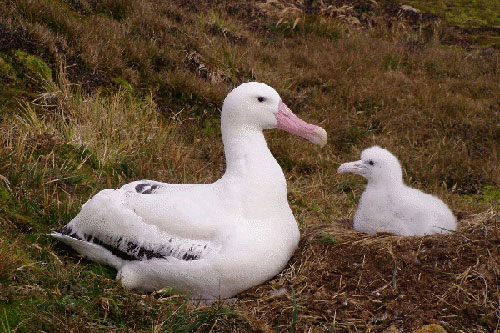Gilles Gauthier of the Université Laval, Quebec, Canada and colleagues in Canada and France have studied colony fidelity and philopatry in Wandering Albatrosses at the Crozet Islands in the southern Indian Ocean utilizing banded birds in long-term study colonies. Their findings have been published recently in the Journal of Animal Ecology.

The paper's summary follows:
"1. Dispersal is a fundamental but still poorly known process in population dynamics and several hypotheses have been proposed to explain its patterns. We studied natal and breeding dispersal and survival in a long-lived seabird, the Wandering Albatross (Diomedea exulans), and examined several hypotheses concerning dispersal patterns in birds.
2. We applied multi-state capture-recapture models to a 36-year data set (1969-2004) collected at three albatross colonies on Île de Possession, Crozet Islands. Because the species has biennial reproduction, we introduced unobservable states in the model to account for the absence of individuals in those years.
3. Adults were highly faithful to their nesting colony but colony fidelity, as well as survival rate, differed slightly among colonies (fidelity ranged from 0.957 to 0.977). Breeding fidelity was highest in the colony where survival was lowest and individuals were not more likely to change colony following a failed breeding attempt than after a successful one. The colony that attracted most dispersers had the lowest density of nesting birds.
4. Philopatry (the probability that young return to breed at a birth site) was generally high but variable among colonies (ranging from 0.70 to 0.92), and survival of young differed little. Philopatry was highest in the largest colony, where the availability of potential mates was presumably greatest. However, among dispersing individuals, the colony that had the lowest density of nesting individuals, not the largest colony, attracted the most recruits.
5. Although size of the colony influenced the decision to stay or to leave in young, density was most influential in the selection of a new colony among both adult and young dispersers. Our results support the hypothesis that philopatry is the strategy favoured by most recruits and that conspecific attraction can explain variation in the level of philopatry among colonies but not settlement patterns among dispersing individuals."
Reference:
Gauthier, G., Emmanuel Milot, E. & Weimerskirch, H. 2010. Small-scale dispersal and survival in a long-lived seabird, the Wandering Albatross. Journal of Animal Ecology 79: 879-887. (click here).
John Cooper, ACAP Information Officer, 29 October 2010

 Français
Français  English
English  Español
Español